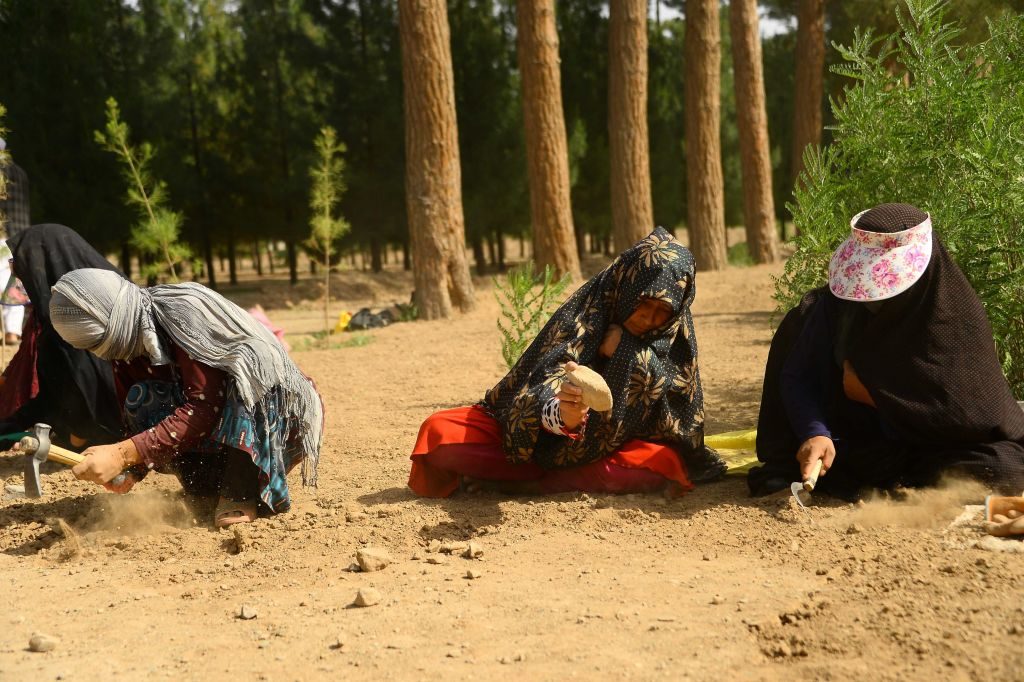The dead body had started to smell but Farzanah barely noticed at first, smoking her heroin pipe undeterred.
The 26-year-old, who was raised as a refugee in Iran, had been an addict for 14 years since returning to her hometown of Zaranj, capital of Afghanistan’s southwestern Nimruz province that borders Iran, and had seen the deaths of many of her peers.
For days the corpse lay by the roadside, covered by a thin blanket. Farzanah eventually saw it being picked up by the municipality – and it was then that reality struck her.
“I had to stop to avoid the same fate. I started using drugs at age 12 when my parents married me off to a distant relative,” she said in a quiet voice, her fingers intertwined, wearing a sweater over her red dress and her hair covered by a thin scarf.
“I was raised a refugee in Iran and only returned to Afghanistan to move in with my new husband, who abused and raped me regularly. He was an addict, so I became one too.”
As more women turn to drugs in Afghanistan, campaigners and medical experts are concerned that the current influx of Afghan refugees from Iran fleeing the coronavirus outbreak could fuel the rising number of female drug addicts.
Many start using drugs in Iran, trying to cope with difficult living circumstances, while others take to heroin or opium once back in Afghanistan, adjusting to the tough realities on the ground in a country where they haven’t lived before.
About 3.5 million Afghans live in Iran, many born and raised there and about 900,000 refugees, according to estimates by the United Nations’ refugee agency UNHCR.
Exact numbers, however, are hard to come by. Many are smuggled there and live in hiding, undocumented and working as daily labourers.
RETURNING HOME
But since the coronavirus outbreak, voluntary returns have jumped as the death toll rises in Iran, with as many as 14,000 people a day returning at the peak to Afghanistan which is responsible for about 90% of the world’s opium production.
The International Organization for Migration has recorded 138,013 people returning from Iran between January 1 and March 14. While numbers were similar to last year, they spiked in mid-March with most returns voluntary.
Zaranj’s police department, said the movement of refugees and the start of the annual opium harvest this month could fuel the problem of female addiction further.
“It’s a growing trend and it’s worrying,” Dr Said Khalil Kazemi, who runs Zaranj’s only drug rehabilitation centre for women.
Hundreds of women are treated in this 20-bed facility every year with overcrowding a major issue. Many of the addicts are returnees, desperate at the prospects in their home country where conflict and a spiralling economy dictate everyday life.
“Many women turn to drugs because their family members are addicted, due to psychological pressure and abuse, or even forced deportation,” said Kazemi.
No estimates are available on how many women are addicts.
Afghanistan’s National Drug Use Survey found there were between 2.9 million and 3.6 million drug users in the dirt-poor ultra-conservative Muslim country of about 36 million.
Kazemi estimates in urban centres about 10% could be women, concurring with an estimate by Zaranj’s police department.
Farzanah’s awakening was the jolt she needed to seek help.
She said she was determined to stay in the rehabilitation centre for the 90-day detox so that she could see her three children – aged 10, seven and four – who are now in her husband’s custody. Her story is not uncommon.
“Many of my friends use drugs, even women who have newly arrived in Afghanistan,” she said, speaking quietly with female drug use a topic that is rarely mentioned in Afghanistan.
CHEAP AS BREAD
Easy access to drugs and cheap prices have made addiction spike. A week’s dose of heroin costs 500 Afghani ($6.40), while getting high on opium can cost 10 Afghani ($0.10), the price of a piece of bread.
With more women taking up drugs, children are also impacted.
At the rehabilitation centre, Mariam, 35, shares her bedroom with Farzanah. Her children, Hussain, 9, and Abbas, 2, sit beside her. Like the other women, Mariam is wearing a red dress – the hospital uniform for those undergoing detox.
“All of us were addicted,” said Mariam, who did not want to use her full name, sitting with her family that started a joint detox nine days ago. “The first days were especially hard for Abbas. He was screaming and crying.”
An opium user for 15 years, Mariam first saw her children passively smoke opium, but she soon started feeding them small doses of the drug when they were restless.
“I’m worried about going home,” she said, explaining that her husband was still using drugs, unwilling to undergo rehab.
“Women often start using drugs because their husbands do so,” explained Arezu Rahmani, a doctor at the clinic.
“Last year, we had an eight-year-old girl as a patient. She had been married to an addict and was living on the streets – in a tent with her husband and four other men who all raped her.”
According to Rahmani, a handful of women who can’t afford their daily dose of drugs work as prostitutes.
“Some of them arrive here with hepatitis infections – last year we even had two cases of HIV,” she added. “Once treated here, we’ve luckily seen most women stay clean.”
Controlling the province’s drug flow is one of the hardest things, said Sayed Sultan, Nimruz’s governor.
“The mafias behind it are big and powerful,” he said.
At the women’s centre, many of the former addicts have developed close friendships and support systems. They share their bedrooms, means, and stories, even singing and dancing.
“When we walk out of here, we won’t be alone,” Mariam said. “And that’s exactly what will keep us – and our children – from getting into drugs again.”




